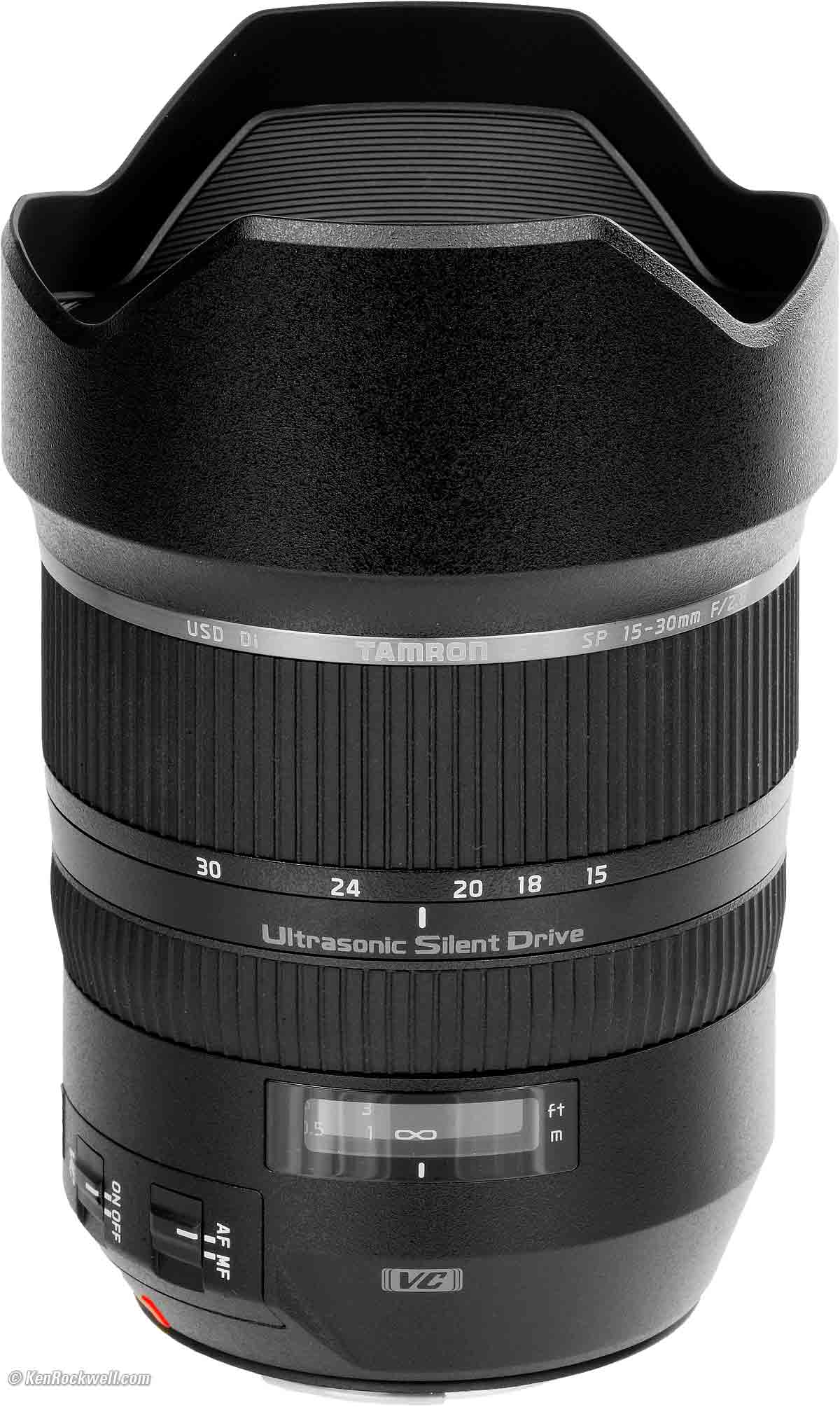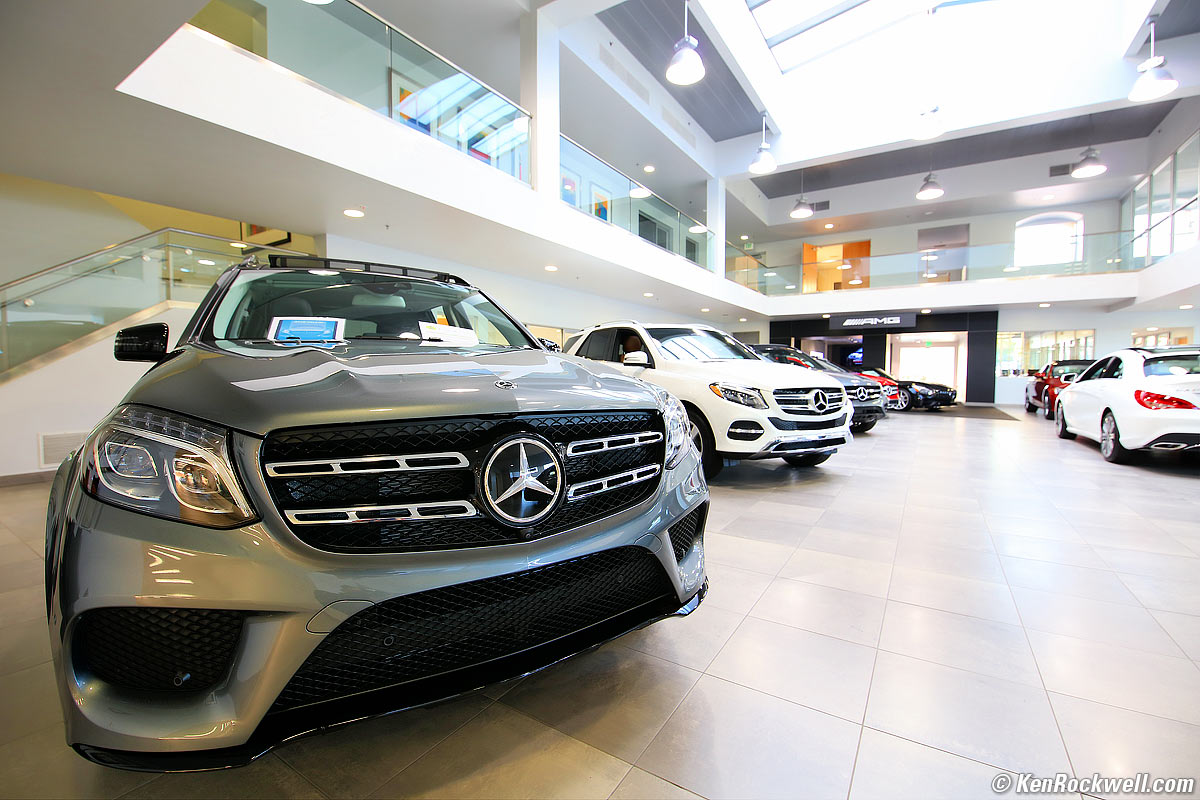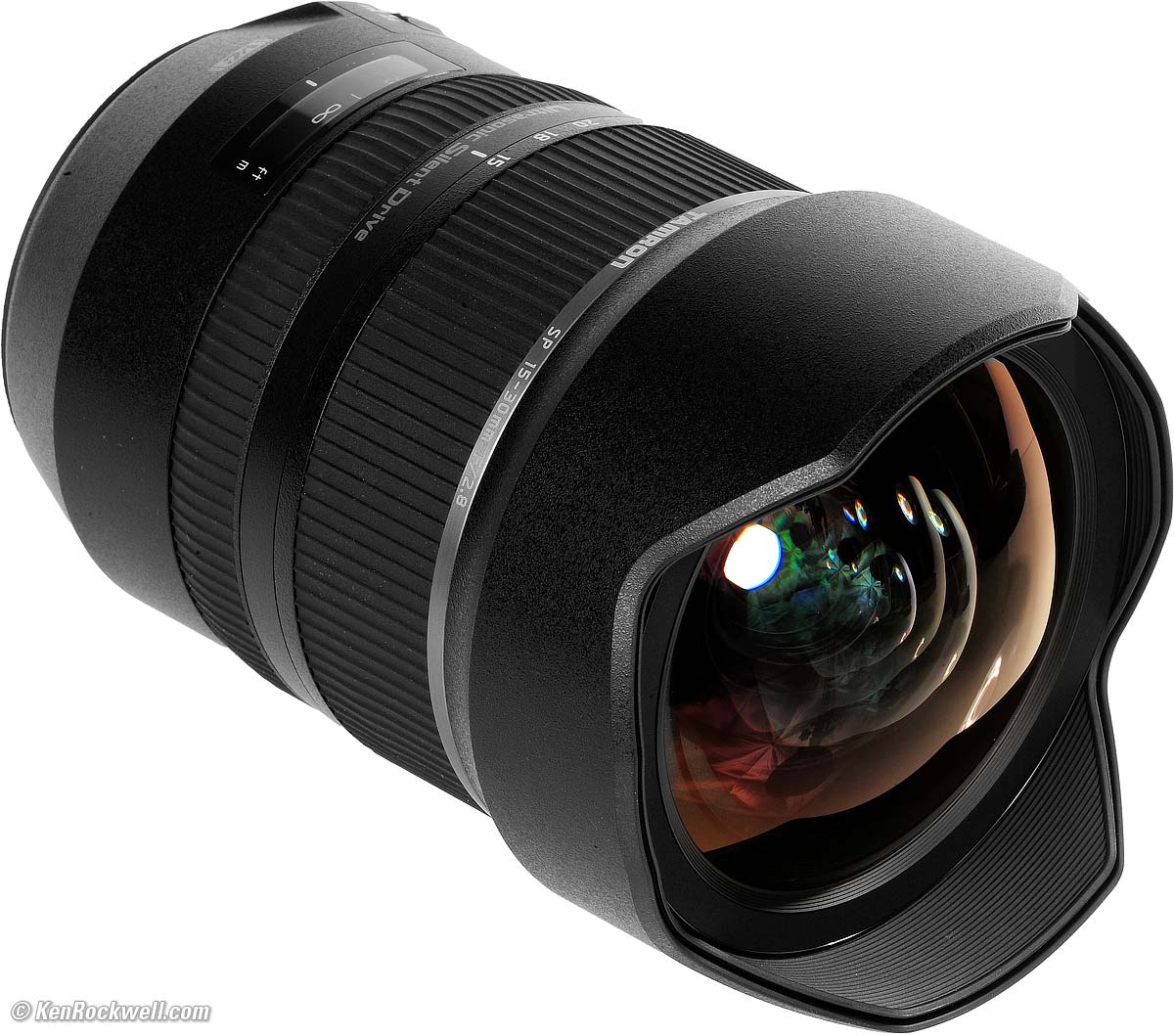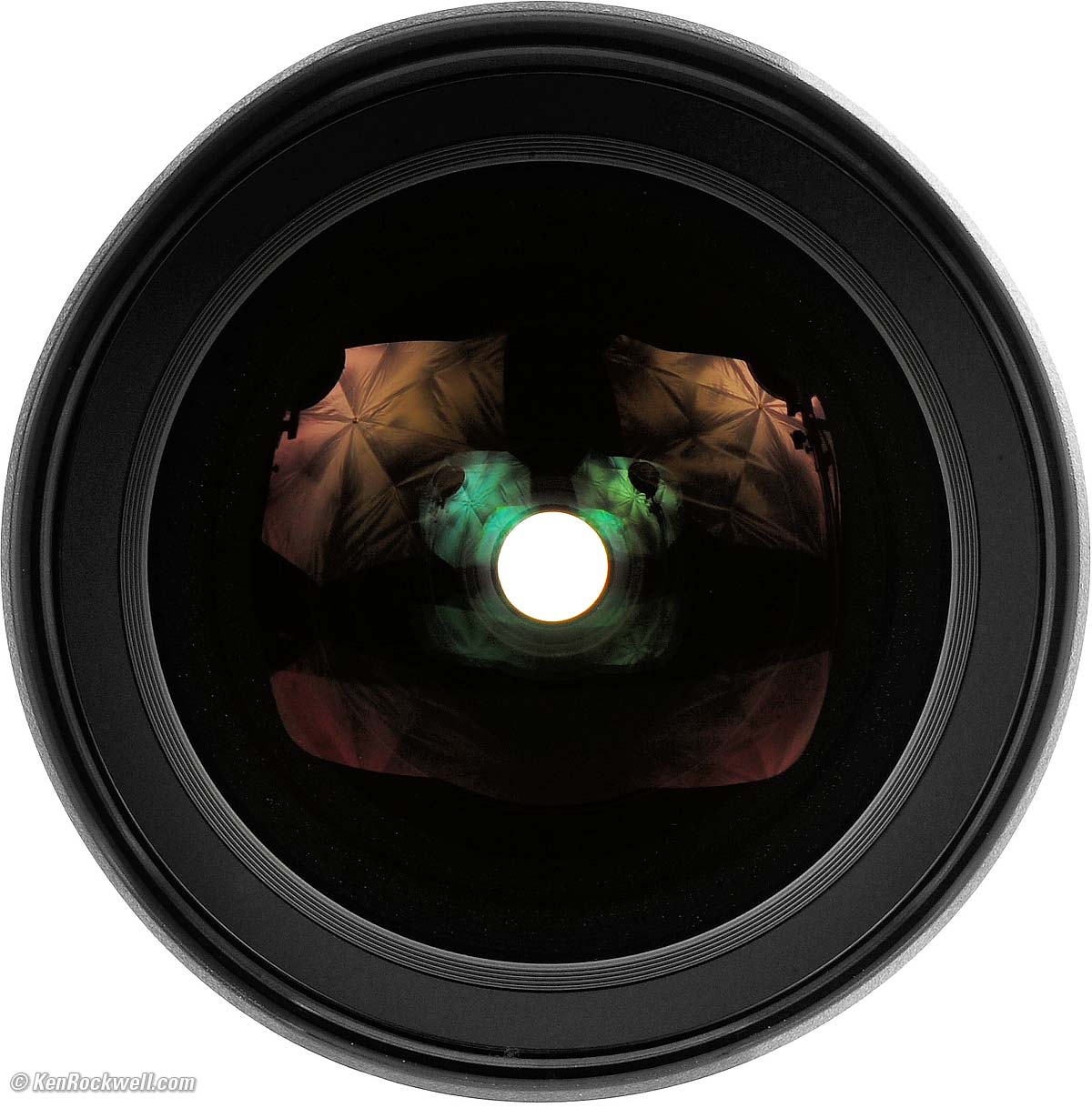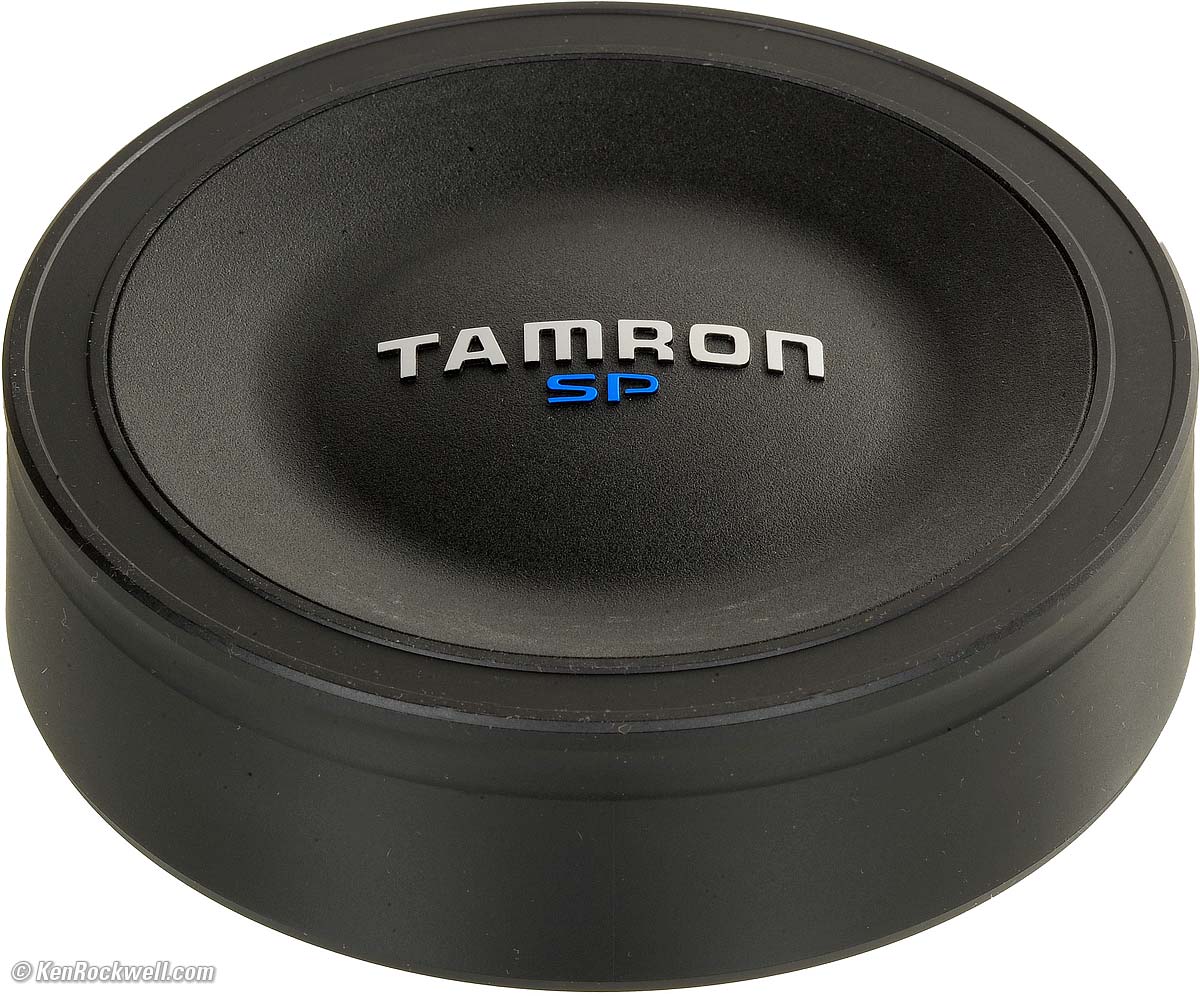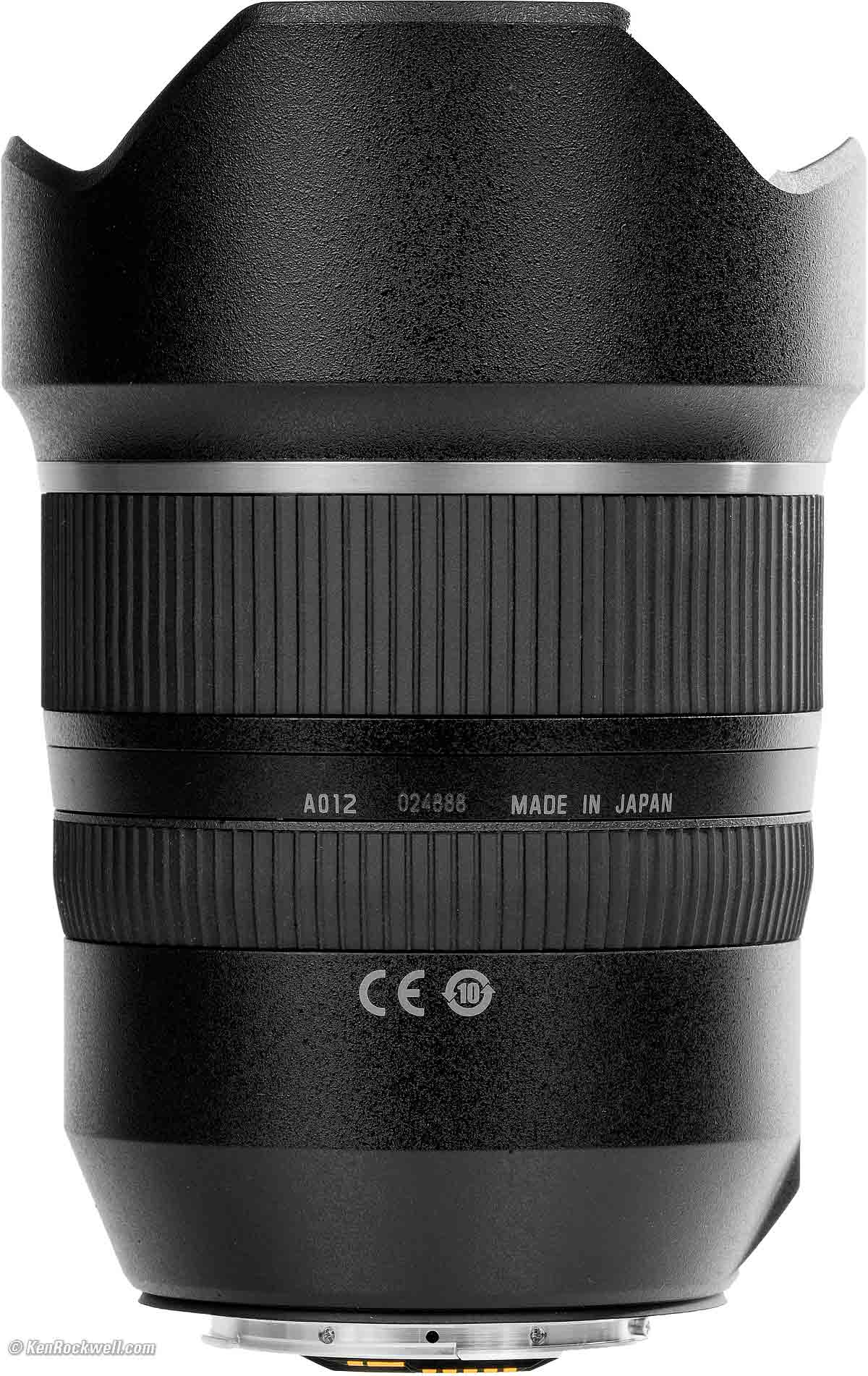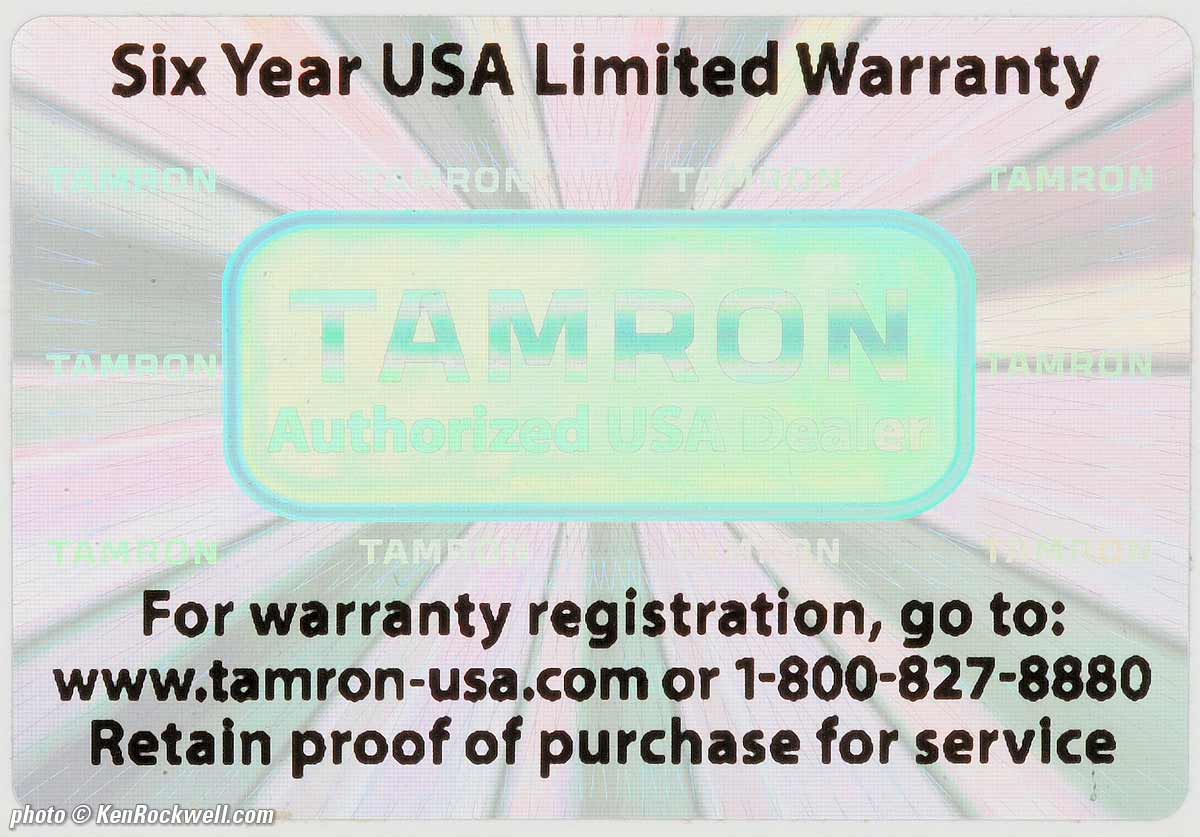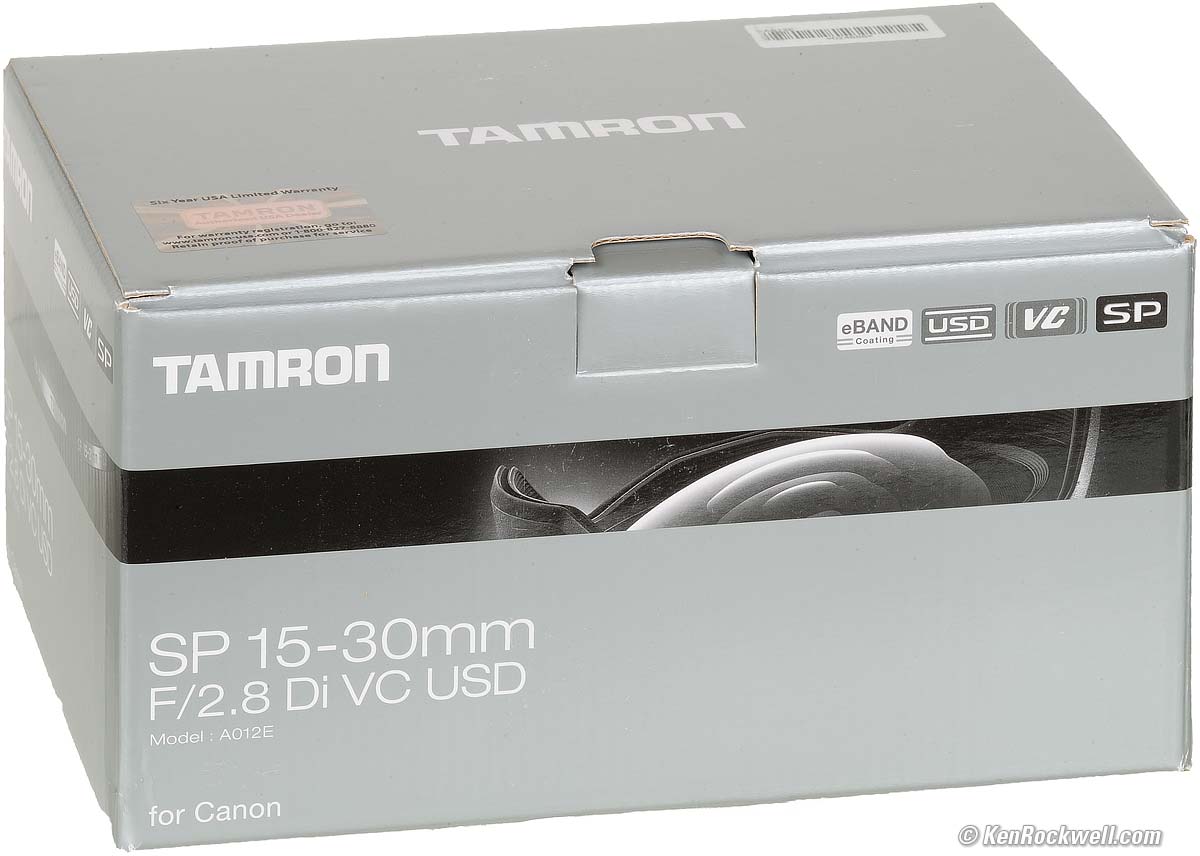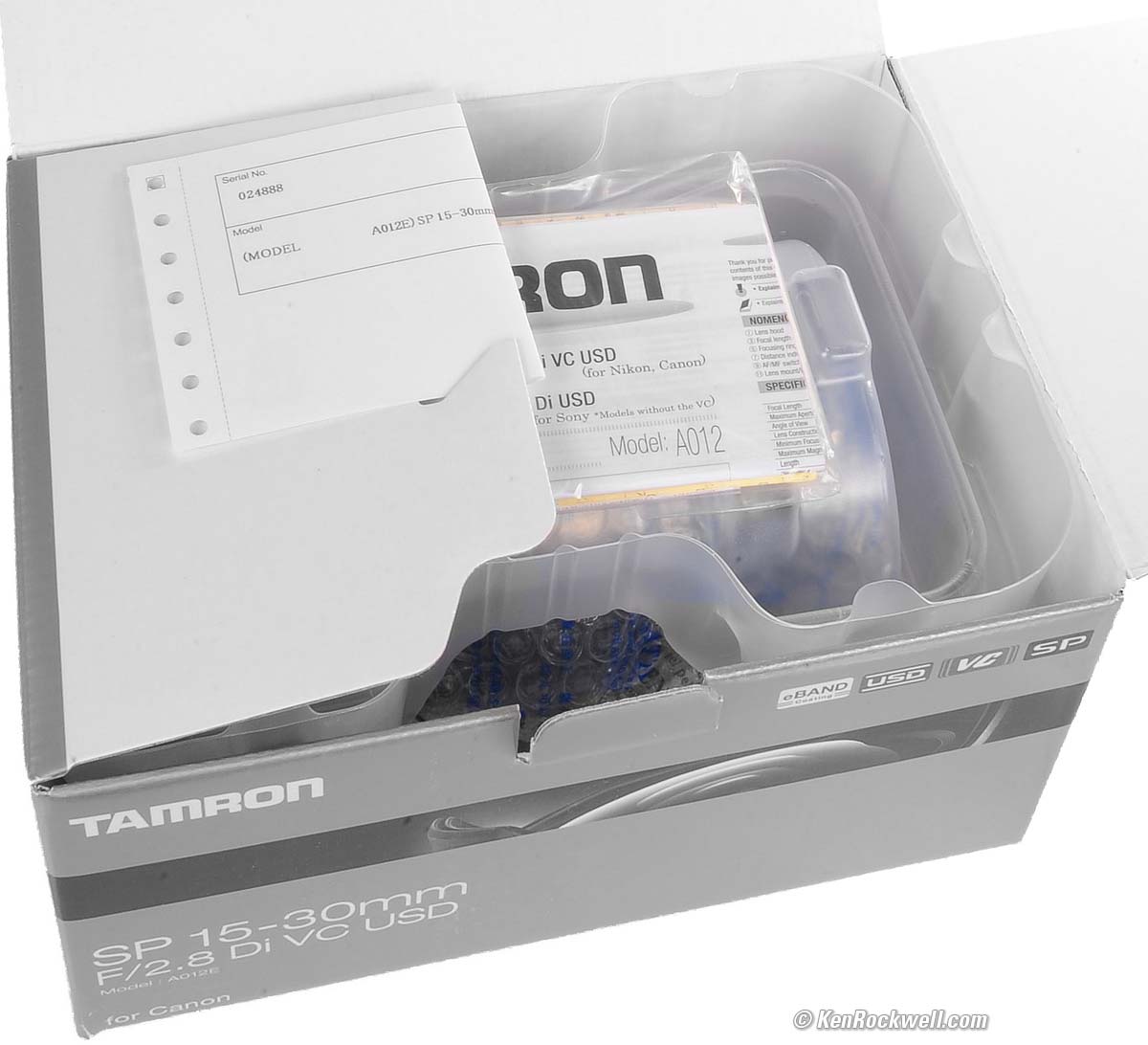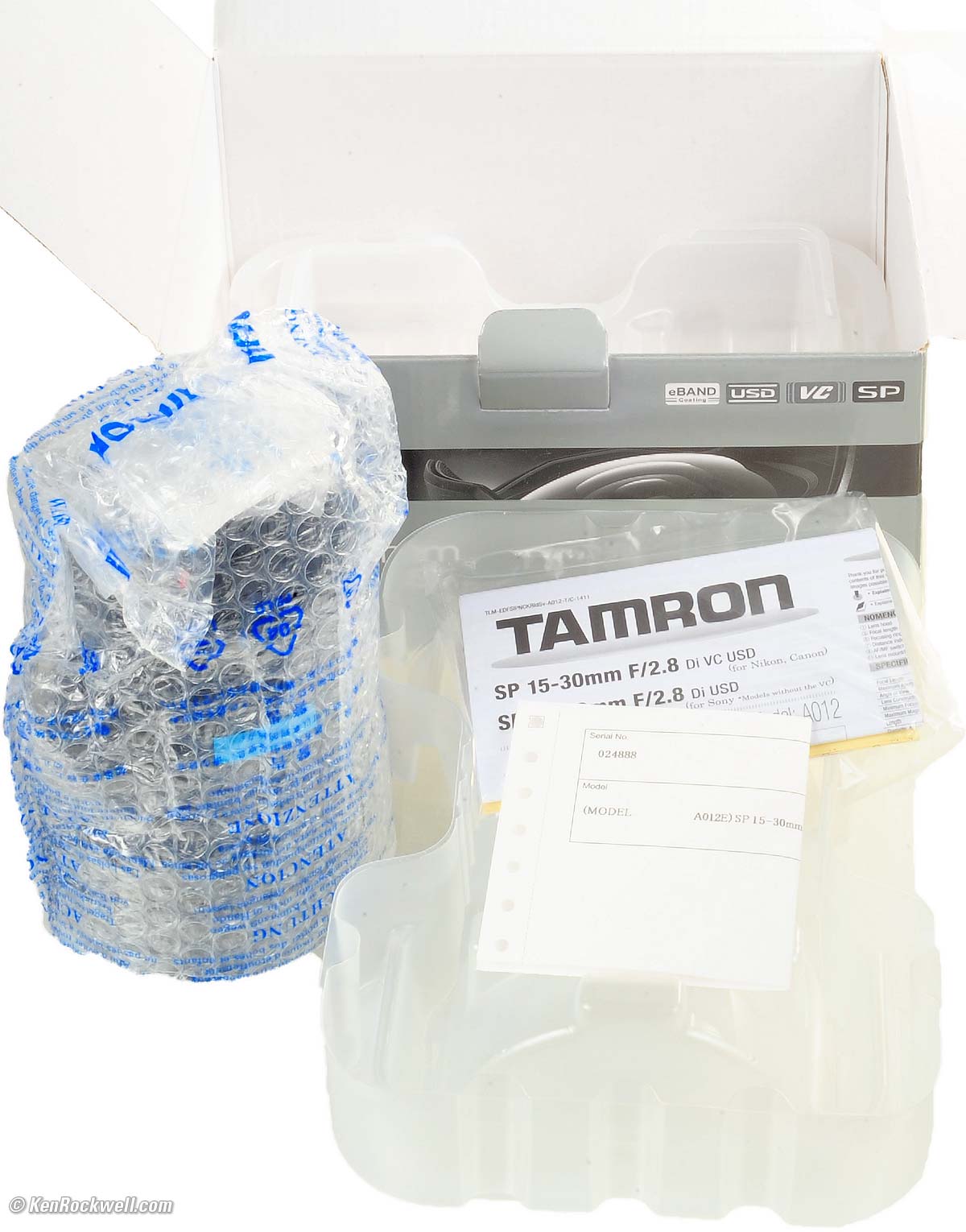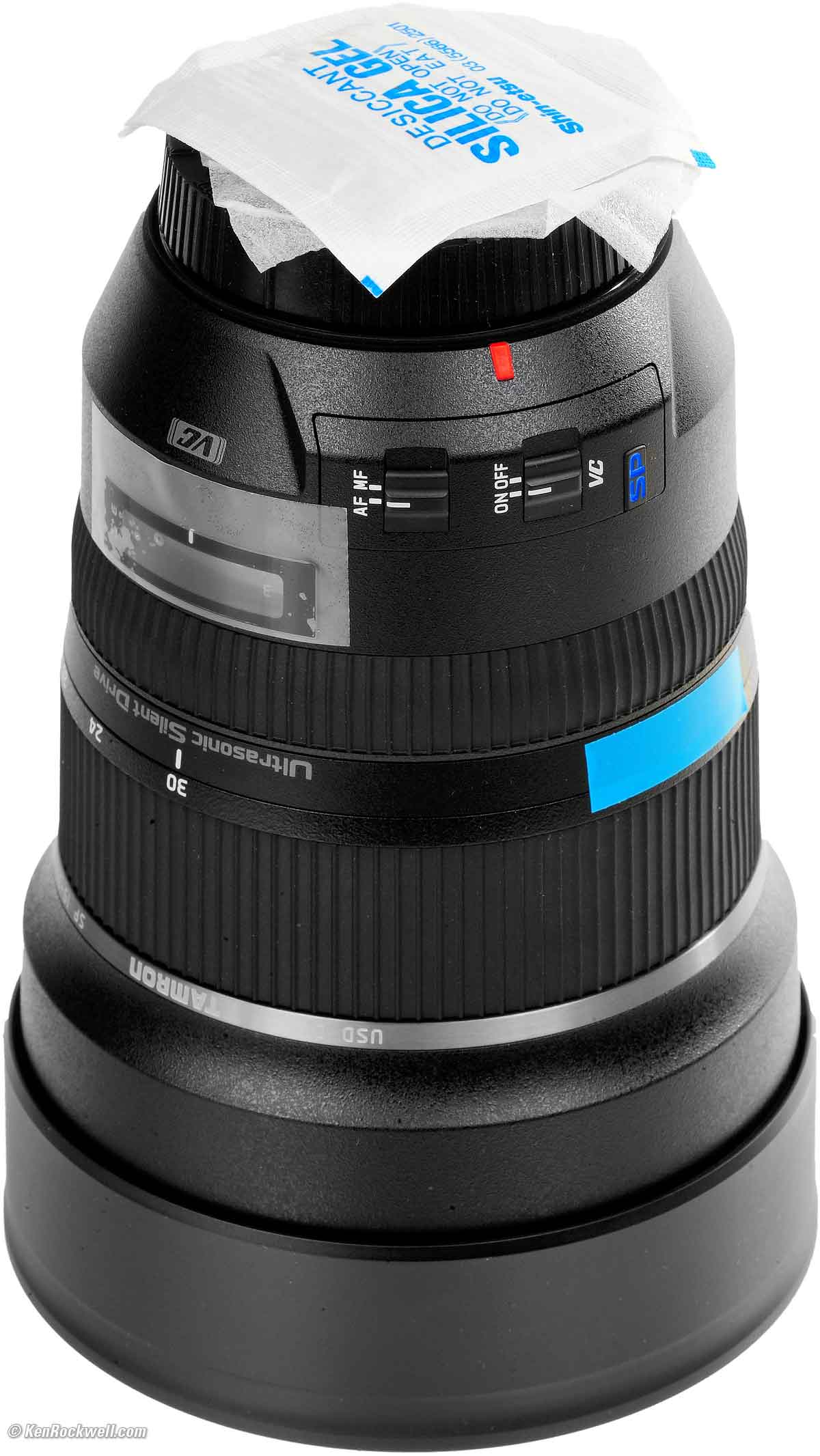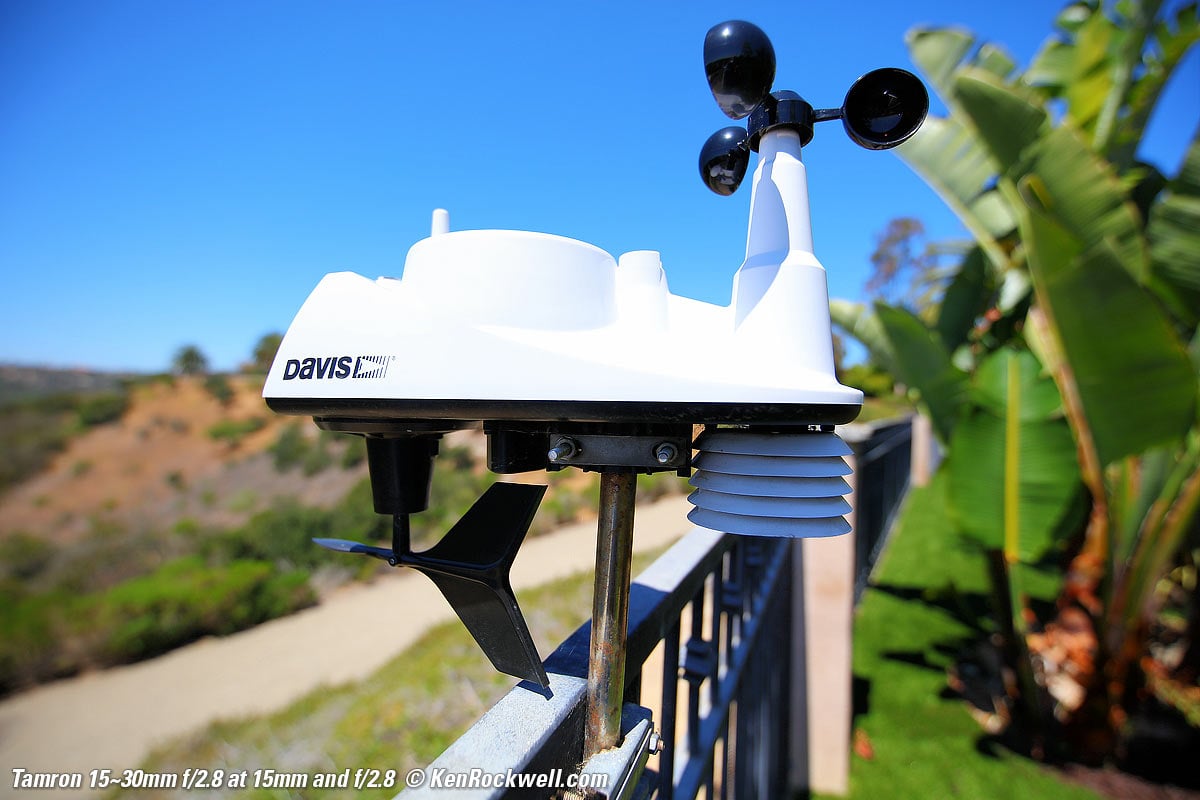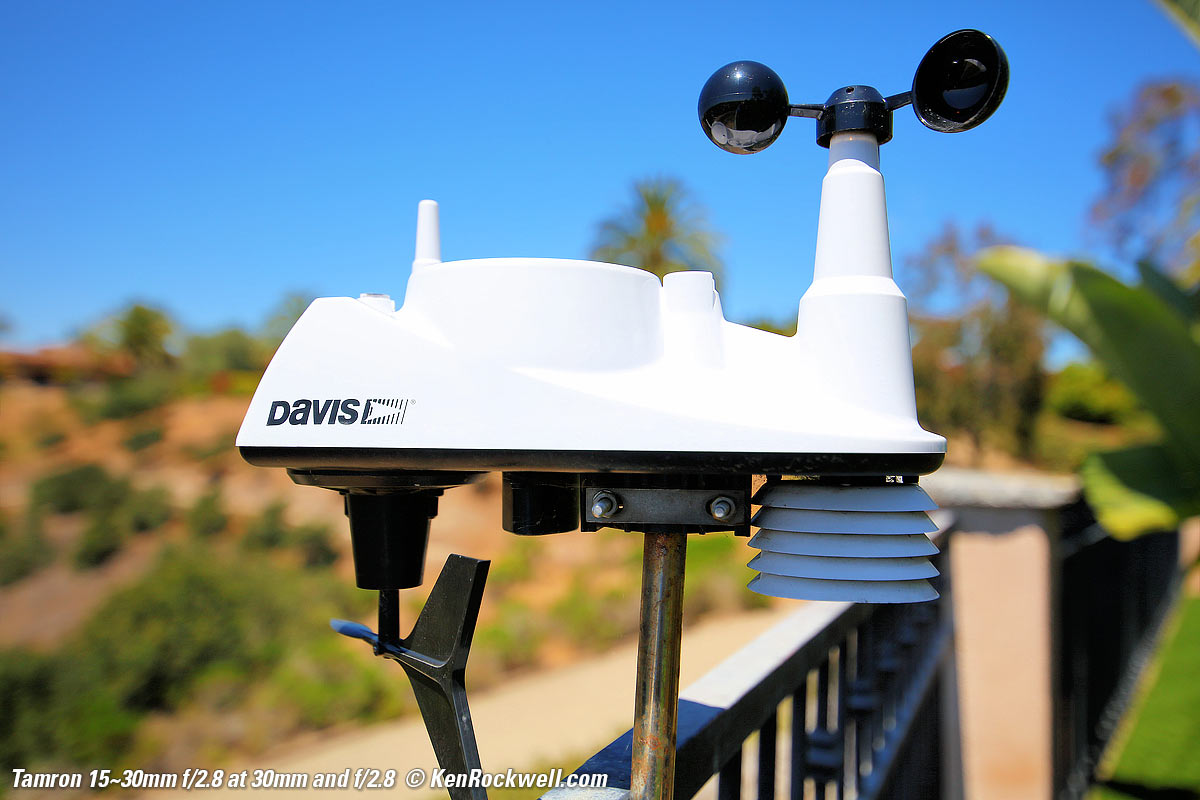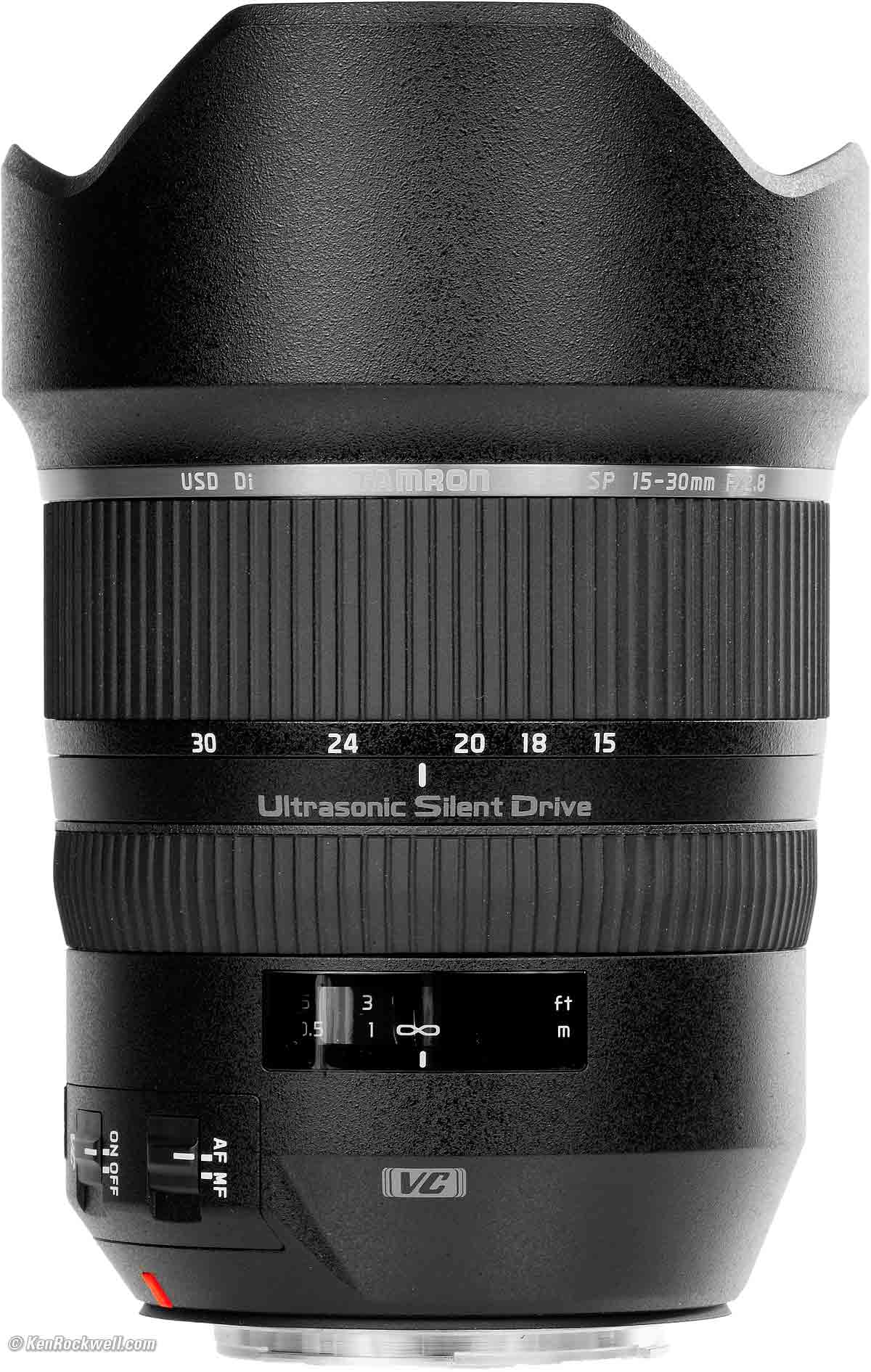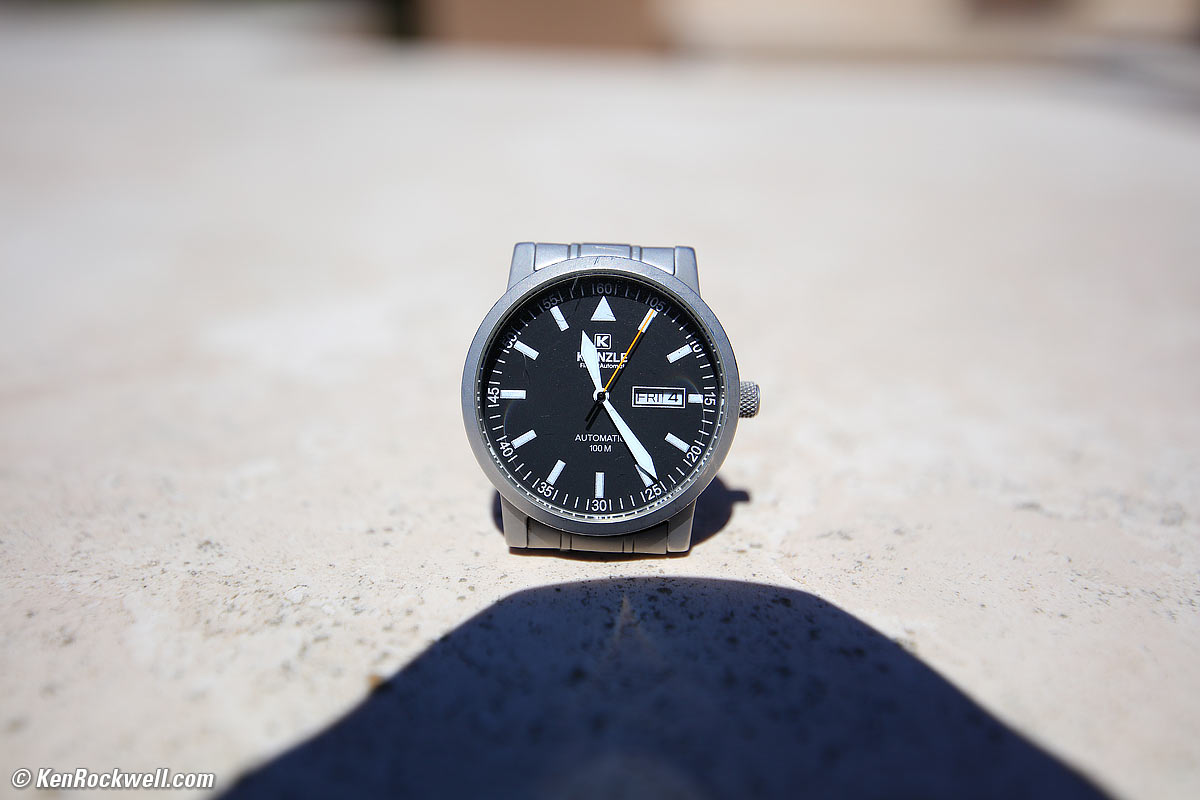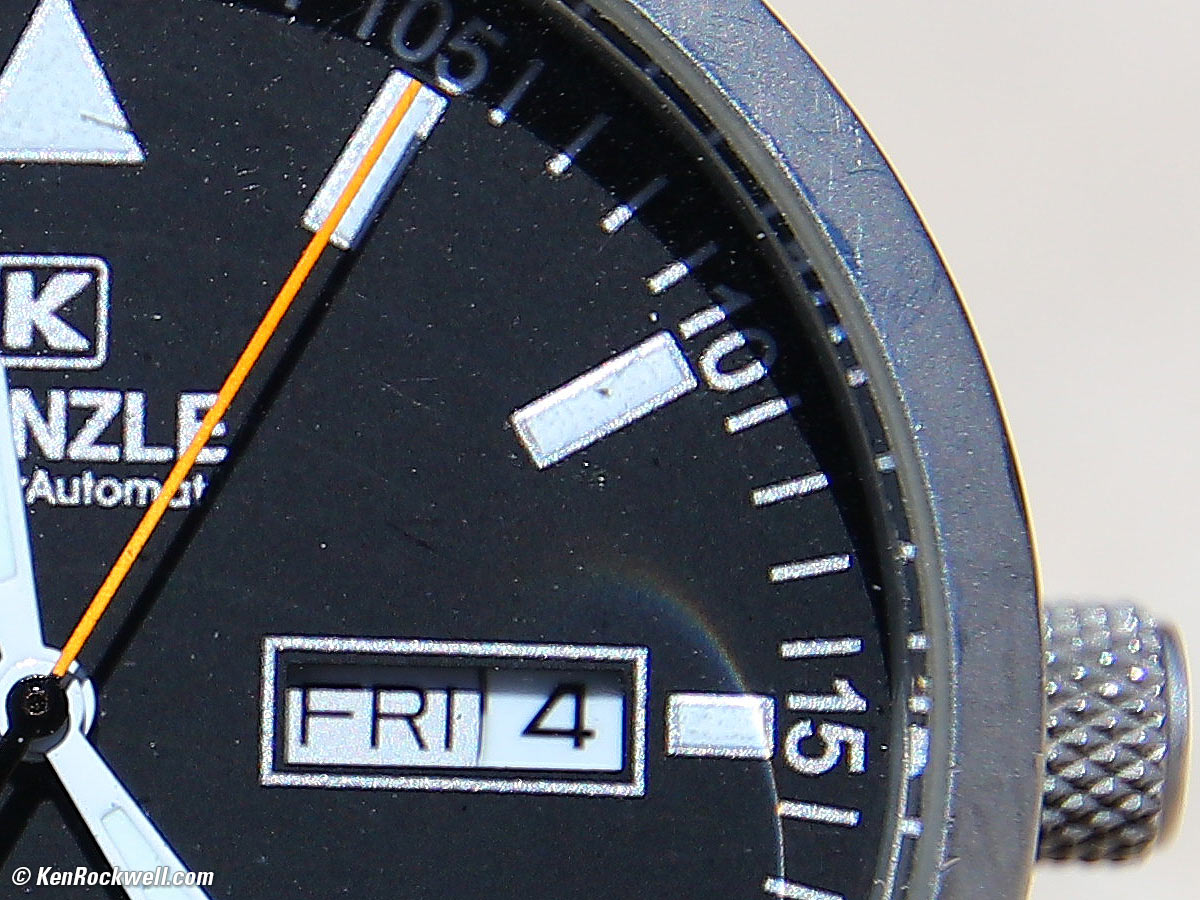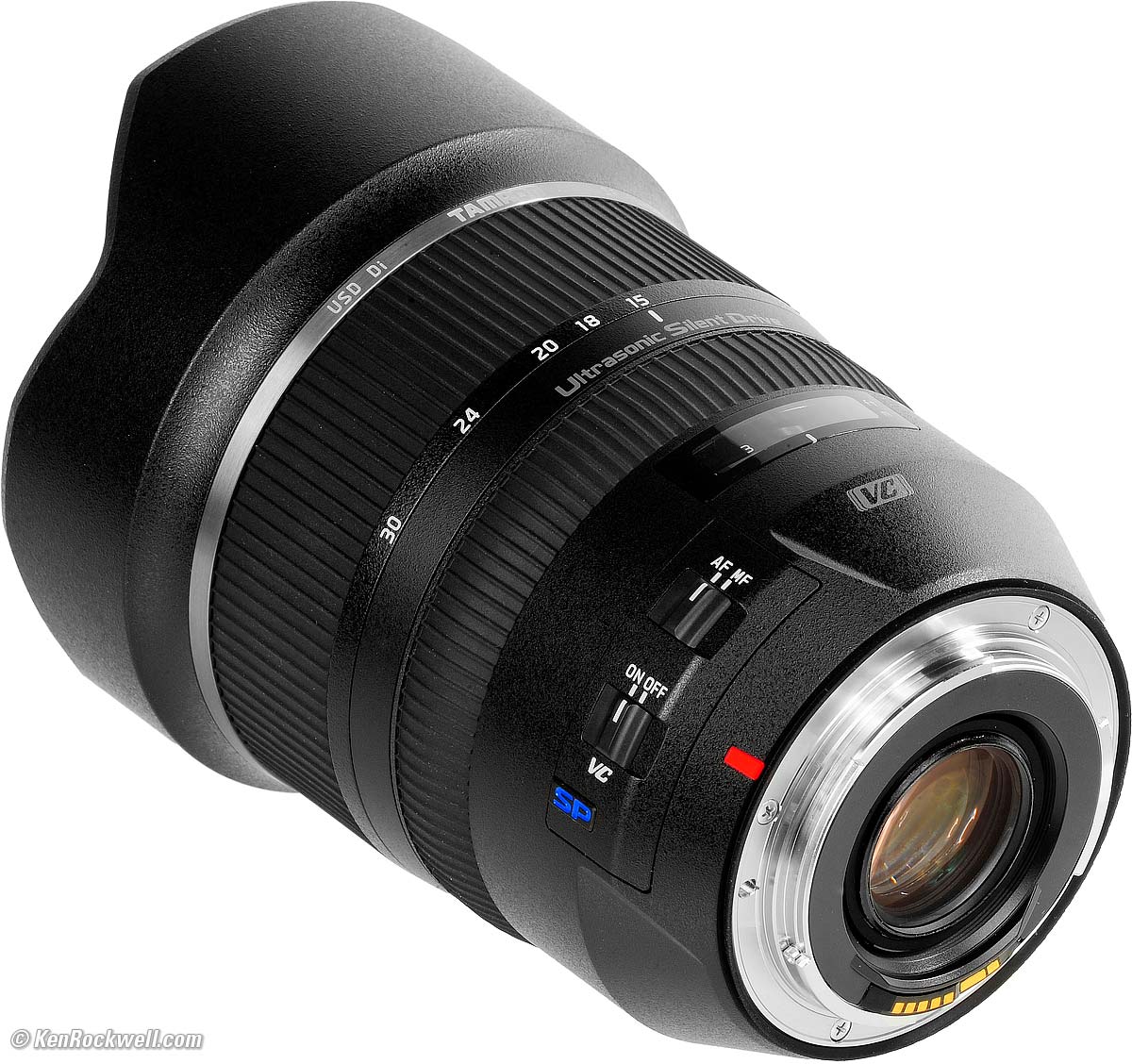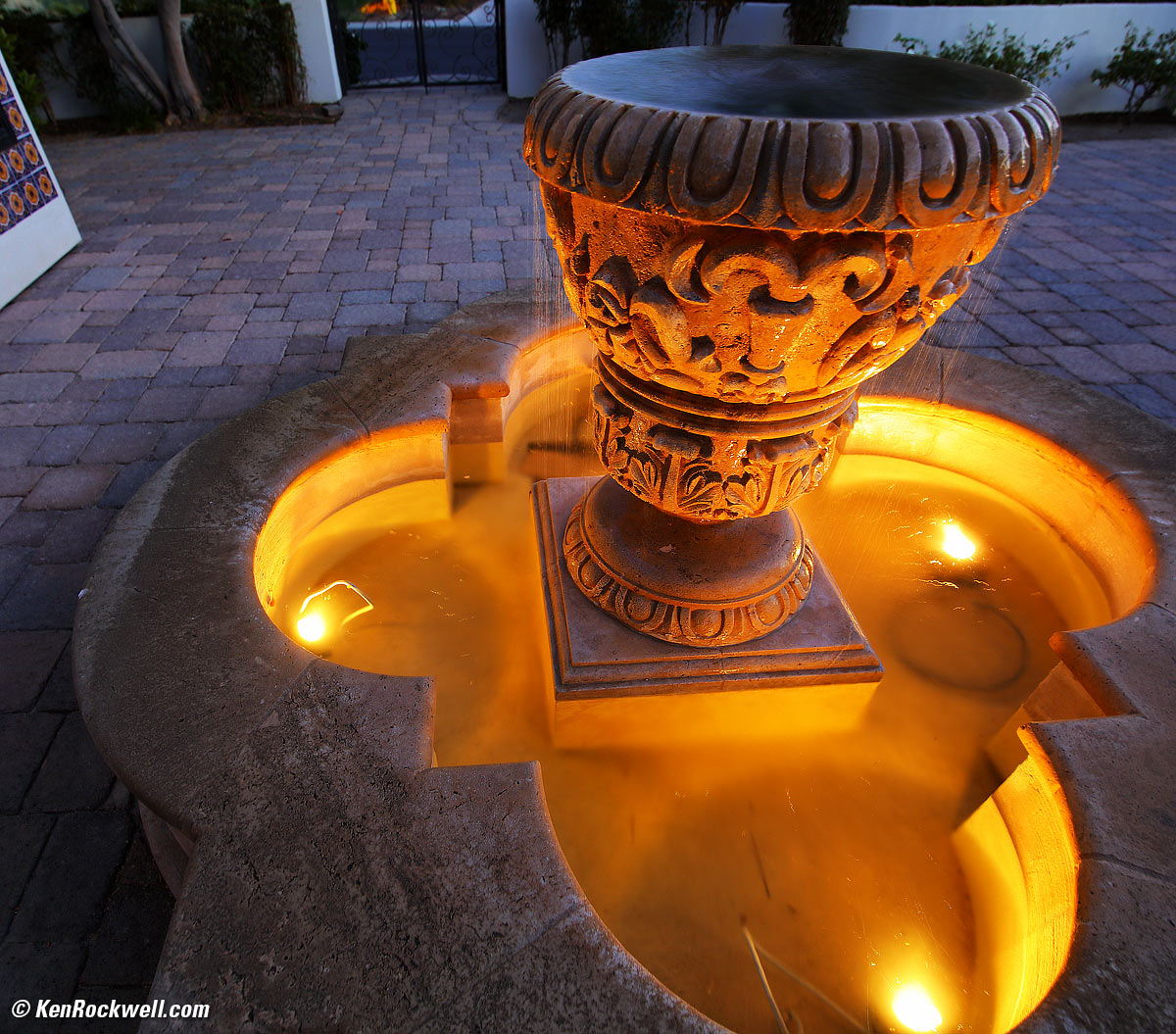Tamron 15-30mm f/2.8
Full-Frame VC Di USD (2015-2018)
Sample Images Intro Format Compatibility
Specs USA Version Unboxing Performance
Compared Usage Recommendations
Tamron SP 15-30mm f/2.8 Di VC USD (takes no filters unless you buy a special adapter, 38.1 oz./1,079g, 0.9'/0.28m close focus, about $1,099) bigger. I got my Canon version at B&H, which I'd also get at Adorama or at Amazon. There is a Nikon version available at B&H, at Adorama and at Amazon. There's also a Sony version at B&H, at Adorama and at Amazon — but the Sony version has no image stabilization and does not work on Sony E-mount mirrorless cameras. The Sony version only works on the old A-mount Sony DSLRs and Minolta Maxxum cameras from the 1980s.
This all-content, junk-free websites biggest source of support is when you use those or any of these links to my personally-approved sources when you get anything, regardless of the country in which you live. Tamron does not seal its boxes in any way, so never buy at retail or any other source not on my personally approved list since you'll have no way of knowing if you're missing accessories, getting a defective, damaged, returned, non-USA, store demo or used lens. Get yours only from the approved sources I use myself for the best prices, service, return policies and selection. Thanks for helping me help you! Ken.
May 2018 Canon Sony Nikon Tamron Fuji LEICA Zeiss Hasselblad all reviews
NEW: Tamron 15-30mm f/2.8 G2 for Canon and for Nikon F DSLR. 31 August 2018
Nikon 14-24mm f/2.8 G FX (check price)
Nikon 14mm f/2.8 FX (check price)
Nikon 17-35mm f/2.8 FX (check price)
Nikon 16-35mm f/4 VR FX (check price)
Canon 11-24mm f/4 L (check price)
Canon 16-35mm f/2.8 L III (check price)
Canon 16-35mm f/4 L IS (check price)
Canon 14mm f/2.8 L II (check price)
Sony 16-35mm f/2.8 GM (check price)
Sony 12-24mm f/4 G (check price)
Sample Images
Top Sample Images Intro Format
Compatibility Specs USA Version
More images also throughout this review. All the images in this review are from NORMAL JPGs; no RAW files, or FINE JPGs were used.
Mercedes, 03 May 2018. Canon 5DS/R, Tamron 15-30mm at 15mm at f/4 hand-held at ⅛ second at Auto ISO 200, Perfectly Clear. bigger or full 50MP resolution or camera-original © 50MP file. Only the car in the front is in any sort of focus, this is normal.
Introduction
Top Sample Images Intro Format
Compatibility Specs USA Version
|
I buy only from these approved sources. I can't vouch for ads below. |
This Image-Stabilized Tamron 15-30mm f/2.8 is priced well below any f/2.8 zoom from Canon, Sony or Nikon, and it's also the only stabilized f/2.8 ultra wide on the planet. It's an excellent lens regardless of price; sharpness, distortion, chromatic aberration and everything perform at an excellent level.
Stabilization is extraordinary: I get perfectly sharp shots most of the time at a half second at 30mm, and at a full second hand held at 15mm!
Feel free to read the rest of this review, but for all practical purposes this lens takes the same pictures as the other lenses and then adds optical stabilization on top of it, all for a fraction of the price of other f/2.8 lenses.
The gotcha is that there are no lens profiles so you'll have no option for automatic in-camera distortion correction, and on Canon only there will be no correction of lateral color fringes or corner falloff (Nikons correct lateral color and falloff with any lens, no profile needed).
What you lose with this Tamron isn't so much picture quality as the potential for the camera you buy ten years from now not working with this lens, but if you're considering this lens today you're probably not worried about ten or twenty years from now. Even the reviews at Amazon love it.
Just grab the genuine mechanical focus ring at any time for instant manual-focus override.
Good
 Adds stabilization not found in other f/2.8 ultrawide lenses, and the stabilization is superb.
Adds stabilization not found in other f/2.8 ultrawide lenses, and the stabilization is superb.
 Sharp.
Sharp.
 Inexpensive.
Inexpensive.
 Great optical performance.
Great optical performance.
 Fast and nearly silent autofocus.
Fast and nearly silent autofocus.
Bad
 For the price, nothing.
For the price, nothing.
Missing
 No lens profiles for in-camera corrections. Nikons can correct any lens for lateral chromatic aberrations and falloff without a profile, but Canon can't correct these without a profile. No camera can correct this lens' distortion without a profile — and neither Canon nor Nikon are going to offer profiles for a Tamron lens.
No lens profiles for in-camera corrections. Nikons can correct any lens for lateral chromatic aberrations and falloff without a profile, but Canon can't correct these without a profile. No camera can correct this lens' distortion without a profile — and neither Canon nor Nikon are going to offer profiles for a Tamron lens.
 No Sony E-mount version; the Sony version is only for the old Sony/Minolta A-mount, not for today's hot mirrorless cameras.
No Sony E-mount version; the Sony version is only for the old Sony/Minolta A-mount, not for today's hot mirrorless cameras.
 The Sony A-mount version has no image stabilization. Tamron cheaped-out and leaves you only with the camera's internal stabilization, if your Sony A-Mount camera has it.
The Sony A-mount version has no image stabilization. Tamron cheaped-out and leaves you only with the camera's internal stabilization, if your Sony A-Mount camera has it.
Format
Top Sample Images Intro Format
Compatibility Specs USA Version
This is a full frame lens, and I'm reviewing it as such.
It works great on APS-C cameras, on which you may make the usual inferences.
Compatibility
Top Sample Images Intro Format
Compatibility Specs USA Version
Caution
No camera maker authorizes Tamron to make lenses for their cameras, and no camera maker authorizes you to use this lens on their cameras. If it doesn't work, talk to Tamron, not to Nikon, Canon or Sony.
While it seems very compatible, there is always the potential that something won't work on your camera, especially in the future as newer camera models come out.
No worries, so long as you get yours from an authorized source you can return it for a full cash refund if you don't love it or it doesn't work on your camera today; there's no risk. The risk is if it doesn't work years from now on a newer camera.
Canon
The Canon version should work flawlessly on every Canon DSLR and every Canon 35mm autofocus (EOS) camera made since about 1995.
I tried it on my old original 5D (2005), Digital Rebel XTi (2006), EOS 3 (1998) and EOS 1V (2000) and everything is fine.
Only on my very oldest EOS 620 and EOS 650 from 1987 wouldn't autofocus or work IS — but you still can focus manually and depth-of-field preview and exposure all work fine.
Thus it seems fine on all Canon digital as well as any Canon 35mm camera sane people are likely to be using today. If you're shooting 35mm, do yourself a favor and be shooting the EOS 3 or EOS 1V; they sell for nearly nothing today.
It should work on Canon's mirrorless EOS-M cameras, but only if you use the EOS-M adapter.
Nikon
The Nikon version should work perfectly on all FX Nikons and all DX Nikons. It uses what should be an AF-S focus system (introduced by Nikon in 1998) and uses a traditional mechanical aperture actuator pin introduced by Nikon in 1959.
It also should work great with most 35mm AF Nikon cameras, but won't work with any manual-focus cameras because it has no aperture ring. It will always shoot at f/22 on manual-focus cameras.
See Nikon Lens Compatibility for details on your camera. Read down the "AF-S"and "G" columns. You'll get the least of what these two columns say, as "G" is actually a downgrade with modern Nikon lenses that removes the aperture ring and therefore compatibility with older 35mm cameras.
Sony
There is no version for Sony's E-mount mirrorless cameras.
The Sony version is for the old A-mount invented in 1986 for Minolta's 1980s 35mm SLRs and used by Sony for their old DSLRs.
This is a DSLR lens, not a mirrorless lens, and not optimized for mirrorless sensors even if you used an adapter with the Canon version of this Tamron to work on Sony. You're really asking for trouble with a cross-brand adapter.
A better idea is to use the Sony LA-EA3 or LA-EA4 adapters to adapt the Sony A-mount version to work with Sony E-mount mirrorless cameras. That ought to work well, and the less expensive LA-EA3 should be all you need, but the 15-30mm's optics aren't optimized for mirrorless sensors, I'd pass on it.
For Sony mirrorless I'd get the awesome new Sony 12-24mm f/4 G (check price) and never look back. Yes, it costs more than this lens, but should work so much better on Sony E than anything else adapted to it. The Sony 12-24 also goes wider, has superb optics and interfaces perfectly with Sony's E cameras.
Tamron 15-30mm f/2.8. bigger.
Specifications
Top Sample Images Intro Format
Compatibility Specs USA Version
Name
Tamron calls this the Tamron SP 15-30mm f/2.8 Di VC USD (The Sony version isn't VC):
SP: Special Performance; Tamron has called most of their lenses this since at least the 1970s.
Di: Works on digital cameras - so?
VC: Vibration control (Image Stabilization).
USD: Ultrasonic Silent Drive autofocus motor.
Optics
18 elements in 13 groups.
3 LD Low Dispersion elements, which help reduce secondary axial chromatic aberration.
Two molded glass and one Expanded Glass Molded aspherical elements.
No high refractive-index elements.
Fluorine front coating to resist dirt and smudges.
Pumper zoom, but all the groups move inside the barrel so nothing seems to move externally except the front element.
Coverage
Full-frame.
Also covers APS-C, but this is a silly lens to use on APS-C.
Diaphragm
Tamron 15-30mm f/2.8. bigger.
9 rounded blades.
Tamron claims it stays nearly circular even at f/5.6.
Stops down to f/22.
Focal Length
15~30mm.
When used on a Nikon DX camera, it sees the same angles of view as a 23~45mm lens sees when used on an FX or 35mm camera.
When used on a Canon APS-C camera, it sees the same angle of view as a 24~48mm lens sees when used on a full-frame or
See also Crop Factor.
Angles of View
Full Frame
110.5º ~ 71.5º diagonal.
APS-C
88.9º ~ 49.9º diagonal.
Autofocus
Internal focus.
No external movement as focused, so no air or dust is sucked in.
Focus Scale
Yes.
Infinity Focus Stop
No.
Depth of Field Scale
No.
Reproduction Ratio Scale
No.
Infrared Focus Indices
No.
Close Focus
0.9 feet (0.28 meters).
Maximum Reproduction Ratio
1:5 (0.20 ×).
Image Stabilizer
Yes.
Filters
None.
Front Cap
Tamron 15-30mm f/2.8. bigger.
Felt-linked big plastic cap.
Case
Not included.
Size
Nikon
3.87" maximum diameter × 5.6" extension from flange.
98.4 mm maximum diameter × 142.5 mm extension from flange.
Canon
3.87" maximum diameter × 5.7" extension from flange.
98.4 mm maximum diameter × 145 mm extension from flange.
Weight
38.055 oz. (1,078.85g) actual measured weight, Canon.
38.8 oz. (1,100 g) specified for Nikon or Canon.
Quality
Made in Japan. bigger.
Made in Japan.
Announced
Teaser "development announcement," September 2014.
Released
30 January 2015 (Nikon and Canon); 24 December 2015 (Sony).
Tamron's Model Numbers
Canon: AFA012C-700.
Nikon: AFA012N-700.
Sony A-mount: AFA012S-700.
Price, USA
$1,099, May 2018.
$1,199, April 2018.
Getting a Legal USA Version
Top Sample Images Intro Format
Compatibility Specs USA Version
This section applies in the USA only.
In the USA, be sure the serial number on your lens (in tiny black-on-black numbers on the bottom between A012 and MADE IN JAPAN) matches the serial number on the top of the box and on the warranty papers inside the box, and be sure your box has this six-year USA hologram sticker:
Tamron USA hologram sticker. bigger.
If not, you got ripped off with a gray market version from another country. This is why I never buy anyplace other than from my personally approved sources. You just can't take the chance of buying elsewhere, especially at any retail store, because non-USA versions have no warranty in the USA, and you won't even be able to get firmware or service for it — even if you're willing to pay out-of-pocket for it when you need it!
If a gray market version saves you $400 it may be worth it, but for $200 or less I wouldn't risk having no warranty or support.
Always be sure to check your box while you can still return it, or just don't buy from unapproved sources or at retail so you'll be able to have your camera serviced and get free updated firmware as needed.
Get yours from the same places I do and you won't have a problem, but if you take the risk of getting yours elsewhere, be sure to check everything while you still can return it.
Unboxing
Top Sample Images Intro Format
Compatibility Specs USA Version
The box is a common micro-corrugated box:
Tamron 15-30mm f/2.8. bigger.
The box is completely unsealed. There is no way to know if anyone else has been fiddling with your lens, swapping parts and accessories, or even if it's a used lens. This is why it's critical only to buy from an approved online source, since they ship from automated warehouses where no shifty salesmen or customers ever get to touch your new camera before it ships. While new $5 CDs, DVDs, Blu-Rays and bottles of milk and drinking water are sealed and quite obvious if anyone's opened them, paradoxically Tamron doesn't bother sealing anything, so your only insurance is to buy only from a trusted online dealer.
Open the top flap and you should see the bare serial number slip carefully tucked into a slot in the left flap. If it's just sitting on top of the other paperwork, that suggests someone's been in there before.
Tamron 15-30mm f/2.8. bigger.
Inside the box are the instructions in a plastic bag and two molded clear plastic sections that hold the lens. The lens is wrapped in bubble-wrap with TAMRON printed on it.
Tamron 15-30mm f/2.8. bigger.
Take your new lens out of the bubble wrap and you'll see that it has protective plastic covering the clear distance window, there are sheets of protective soft white paper at the rear cap, and a silica gel pack thrown in.
The interesting part is that Tamron uses two pieces of blue tape on each side of the lens to keep the zoom ring set to 30mm in shipping:
New, Unused Tamron 15-30mm f/2.8. bigger.
Performance
Top Sample Images Intro Format
Compatibility Specs USA Version
Overall Autofocus Manual Focus
Breathing Bokeh Distortion Ergonomics
Eyeblow Falloff Filters Flare & Ghosts
Front Cap Lateral Color Fringes
Lens Corrections Macro Mechanics
Sharpness Stabilization Sunstars
Overall
The Tamron 15-30/2.8 is an excellent performer. It takes the same pictures as the camera-brand f/2.8 lenses and adds stabilization they don't have.
Autofocus
Autofocus is fast and sure. No problems here. It's nearly silent, too.
Manual Focus
Manual focus is easy. Just slide the real mechanical focus ring with a fingertip any time for instant manual-focus override.
Focus Breathing
Focus breathing is the image changing size as focused in and out. It's important to cinematographers because it looks funny if the image changes size as focus gets pulled back and forth between actors. If the lens does this, the image "breathes" by growing and contracting slightly as the dialog goes back and forth.
The image from this Tamron lens gets smaller as focused more closely. This effect is stronger at the 15mm end.
Bokeh
There is rarely anything out of focus with an ultrawide lens, but if there is, bokeh, the feel or quality of out-of-focus areas as opposed to how far out of focus they are, is pretty good. Backgrounds are soft and smooth. Here are shots at headshot distance:
Davis 6250 weather station, 04 May 2018. bigger or camera-original © file.
Davis 6250 weather station, 04 May 2018. bigger or camera-original © file.
As always, if you want to throw the background as far out of focus as possible, shoot at 30mm at f/2.8 and get as close as possible.
Distortion
The Tamron 15-30 2.8 has typical distortion for a zoom: strong barrel distortion at 15mm and moderate pincushion distortion at 30mm. It has no visible distortion from about 18~20mm.
No camera can correct it automatically because no camera has a lens profile for this lens.
Here are my exclusive Photoshop lens correction filter correction coefficients to correct this distortion manually in your computer. These aren't facts or specifications, these are the results of my research that requires hours of photography and calculations on the resulting data.
The great news is that this distortion is simple, first-order distortion which corrects completely with these factors.
On Full-Frame at 10' (3m) |
|
15mm |
+4.50 |
18mm |
+1.00 |
20mm |
-1.00 |
24mm |
-2.20 |
30mm |
-2.50 |
© 2018 KenRockwell.com. All rights reserved.
Ergonomics
Tamron 15-30mm f/2.8. bigger.
This Tamron is the same as the Nikon 14-24mm or Canon 11-24mm f/4 L. These are all big, fat, heavy lenses with no front element protection other then the built-in petals, and no ability to use a front filter for protection. All weigh about the same and all have big, fat front elements.
This image isn't conveying how big it is until you look at the little lens mount. See how, unlike most lenses, the barrel greatly expands as it gets away from the mount? This lens is about 33% bigger in every dimension than a typical zoom. If it took screw-in filters (which it doesn't), they would be 95mm, not 77mm like most large pro DSLR lenses.
Zoom and focus are as expected. The big zoom ring needs two fingers to work well; you're moving a lot of glass. The focus ring needs just one slightly firm finger to slide it, no need for two fingers.
You can feel the big red mounting index with your eyes closed. Excellent!
This Tamron has its feet and meter distance scales both in the same tiny gray digits. They aren't easy to read, and meters and feet look the same, not bright yellow or green as on Nikon or Canon.
Also the Tamron puts the AF/MF slide switch much higher on the lens so my thumb doesn't directly reach it, which is different from Nikon or Canon. When you reach for what you expect to be the AF/MF switch, instead you reach the VR/IS ON/OFF switch.
Eyeblow
Air pumps in or out of the back of the lens as zoomed.
Depending on your camera you may or may not feel air blowing out of your eyepiece as zoomed.
Falloff
There is very little corner darkening wide-open at f/2.8, and then no visible vignetting at f/4 and smaller, even without any correction.
Canon cameras have no way of correcting falloff because they require a lens profile which doesn't exist for this off-brand lens. Nikon's Vignette Control may or may not improve this.
I've greatly exaggerated the falloff by shooting a gray field and placing these on a gray background:
Falloff on full-frame, no correction.
© 2018 KenRockwell.com. All rights reserved. |
Filters, use with
Forget it. There is no front thread and no rear slot.
You can buy special adapters, but I don't recommend them because often you'll get unintended reflections of bright things behind you from the back of the exposed filter in a holder.
Don't use polarizers on ultrawide lenses; the sky's natural polarization will appear as a dark band in the sky.
Flare & Ghosts
This lens is less resistant to ghosting than other lenses, but I doubt you'll see any unless you go out of your way as I did here, with the sun shining directly into my lens and then exposing for the dark shadows of the palm tree. See more reasonable examples at Sunstars.
Worse case flare at f/8 and 30mm. bigger.
Front Cap
Tamron 15-30mm f/2.8 front cap. bigger.
Tamron's front cap is superior to any other current ultra-ultrawide lens.
Tamron's is a solid plastic cap with a felt lining. It stays on and doesn't let dust in.
Nikon's front cap for their 14-24mm is awful; it has no felt, doesn't fit very tightly, and even when it's on dust can get in around the sides because of all the airspace between the ridges - which also can scratch you barrel.
Canon's front cap for their 11-24mm is also horrible. Canon's cap is a wimpy plastic snap-cap, which also has no felt and allows air and dust flow around the corners.
Lateral Color Fringes
There are few to no color fringes as shot on an uncorrected Canon at 50MP, which is excellent. Even without a lens profile (which doesn't exist anyway) you won't see any unless you really go looking; this lens is far, far better than the Irix 11mm.
There won't be any on Nikon cameras, which by default correct for any that may be there.
Lens Corrections
Nikon
Nikons correct automatically for lateral color fringes (chromatic aberration). No lens profile is needed for this on Nikon.
Nikons cannot correct for distortion because they require a lens profile, which doesn't exist for this off-brand lens.
Canon
Canon has no lens profile for this lens, and obviously isn't going to be writing one for this off brand lens.
Therefore there is no correction for falloff (peripheral illumination), lateral color fringes (chromatic aberration), distortion or diffraction on any Canon camera.
Macro
This lens gets very close, which is pretty good — especially for an ultrawide.
Kienzle Flieger Automat 800/2843, 04 May 2018. Canon 5DS/R, Tamron 15-30mm at 30mm wide-open at f/2.8 at 1/3,200 at Auto ISO 100, Perfectly Clear. bigger or camera-original © file.
Not only does it get very close, this is shot wide-open and it's still very sharp:
1,200 × 900 pixel crop from above. bigger or camera-original © file.
If this is about 6" (15cm) wide on your screen, the complete image would print at a huge 27½″ × 41¼″ (70 × 105 cm) at this same high magnification. If this is about 12" (30cm) wide on your screen, the complete image would print at a mammoth 55 × 82½″ (1.4 × 2.1 meters) at this same extremely high magnification!
Mechanical Quality
Tamron 15-30mm f/2.8. bigger.
This is a gigantic, heavy and well-made plastic-barreled lens. Most of the outside is plastic, and most of the inside is metal.
Front Bumper
None.
Hood
Permanently attached part of the lens barrel.
Plastic.
Filter Threads
None.
Front Barrel
Plastic.
Identity Ring
Grey metal trim ring printed with TAMRON 15-30mm etc. between zoom ring and front barrel.
More identification also printed on bottom of mid-barrel.
Zoom Ring
Rubber-covered plastic.
Middle Barrel
Section between focus and zoom rings: Plastic.
Focus Ring
Rubbery plastic.
Rear Barrel
Section with focus distance window: plastic.
Internals
Plastic and plenty of metal.
Moisture Seal at Mount
Yes.
Mount
Dull chromed metal.
Markings
Paint.
Serial Number
Laser engraved in black-on-black on the bottom of the middle barrel.
Date Code
None found.
Noises When Shaken
Minor clattering.
Made in
Japan.
Sharpness
It's super-sharp corner-to-corner at every setting. Even at f/2.8 it's very sharp in the far corners.
The only limitation to picture sharpness is your skill as a photographer.
By day it's super sharp at normal apertures:
Spanish Desert Home, 08 May 2018, 2:40 PM. Canon 5DS/R, Tamron 15-30mm at 15mm at f/7.1 at 1/250 at Auto ISO 100, Perfectly Clear. bigger or full 50 MP resolution or camera-original © 50MP file.
Here's super sharp shot at f/2.8. Remember that this is a real subject and not everything is in focus, especially the tree trunks close-in at the bottom:
Spanish Desert Home, 08 May 2018, 8:13 PM. Canon 5DS/R, Tamron 15-30mm at 15mm wide-open at f/2.8 for five seconds at ISO 100, exactly as shot. bigger or camera-original © 50MP file.
At f/5.6 everything is super-sharp, although the palm fronds were blowing around and turned into waves in this 20-second time exposure:
Spanish Desert Home, 08 May 2018, 8:29 PM. Canon 5DS/R, Tamron 15-30mm at 15mm at f/5.6 for 20 seconds at ISO 100, exactly as shot. bigger or camera-original © 50MP file.
Image Stabilization
Image Stabilization (IS or Vibration Reduction (VR)) is incredible. I get perfectly sharp images at 50MP most of the time hand-held at a half second at 30mm, and at a full second hand-held at 15mm!
Here's a sample standing with the camera hand-held at eye level for one full second with stabilization:
Desert Fountain at dusk, 08 May 2018, 7:51PM. Canon 5DS/R, Tamron 15-30mm at 15mm hand-held for one-second at f/5 at ISO 100, Perfectly Clear. bigger or full-resolution or camera-original © 50MP file.
Stabilization only works with subjects that hold still, and it's always a good idea in iffy conditions to make several shots so you can pick the sharpest one. You should know how to shoot a rifle; you heed to breathe properly and release the shutter smoothly and at the right time, something most Americans are taught at home, in school or scouting.
In this sample of course only some parts of the fountain are in focus, the rest is simply out of focus and not supposed to be sharp.
Sunstars
With a rounded 9-blade diaphragm there aren't any sunstars at the largest apertures, and from f/8 and on it can give pretty good 18-pointed sunstars on brilliant points of light.
Click any to enlarge:
Click any to enlarge.
Compared
Top Sample Images Intro Format
Compatibility Specs USA Version
This Tamron is optically about as good as the lenses from Canon and Nikon. Not only that, this lens adds stabilization absent from any Nikon or Canon lens this wide or any of their f/2.8 ultrawides. If you're shooting hand-held at slow speeds, this lens will give better, sharper results than from Nikon or Canon's unstabilized lenses.
What you lose is that this Tamron is built only to good consumer levels, while the Nikon 14-24mm f/2.8 G FX (check price) and Canon 11-24mm f/4 L (check price) are built to extraordinary professional standards with mostly metal barrels. Nikon and Canon's lenses are built to withstand a lifetime of full-time professional environmental and physical abuse, while this Tamron is designed for normal people who take care of their equipment.
Every non-camera-brand product has the potential to be, or to become, incompatible with your camera. While it probably will be perfect with your camera today (and if it's not and you get yours from an approved source you can send it back for a 100% cash refund), there's no telling if it will be compatible with whatever new camera you might buy 10 years from now. I'm still using my Canon and Nikon ultrawide lenses that I bought back in the 1990s with my newest digital cameras, but no one can be sure if this Tamron lens will work with cameras 10 years from now. While off-brand makers all smile and try to reassure you today that they'll be around in the future to update lenses, experience has shown that these makers just walk away when it comes to trying to update 10 year old lenses.
Let's be serious: The other 2.8 ultrawides cost a lot more than this Tamron today, and that's real money in your pocket today compared to "what ifs" years from now. If you have work to do and money - or vibration reduction - matters, by all means get this Tamron lens.
This Tamron and all these lenses are super-sharp:
Nikon 14-24mm f/2.8 G FX (check price)
Nikon 16-35mm f/4 VR FX (check price)
Canon 11-24mm f/4 L (check price)
Canon 16-35mm f/2.8 L III (check price)
Canon 16-35mm f/4 L IS (check price)
Sony 16-35mm f/2.8 GM (check price)
Sony 12-24mm f/4 G (check price)
These older lenses are much softer:
Nikon 17-35mm f/2.8 FX (check price) and Nikon 14mm f/2.8 FX (check price). These expensive and well made lenses are optical relics from the 1990s, but since Nikon makes no modern 14mm or 15mm lenses or f/2.8 ultrawide zooms, they continue to sell these dinosaurs.
Canon 16-35mm f/2.8 L II (new 2007-2016 and only available used today) and the Canon 16-35mm f/2.8 L (new 2001-2007 and only available used today) are also older discontinued lenses with inferior optics. Thank goodness Canon makes the modern Canon 16-35mm f/2.8 L III, while Nikon is still selling their ancient 1990s 17-35mm f/2.8 FX and 14mm f/2.8 today.
The Canon 14mm f/2.8 L II (check price) and even older 14mm f/2.8 L (new 1991-2007 and only available used today) are also much softer than this Tamron.
Usage
Top Sample Images Intro Format
Compatibility Specs USA Version
Tamron 15-30mm f/2.8. bigger.
VC ON/OFF
This activates or deactivates Image Stabilization.
Always leave it on (VC/ON), except if you are on a sturdy tripod or making time exposures (OFF).
AF/ MF
This selects auto (AF) or manual focus (MF).
Always leave it at AF, at which setting you can move the focus ring at any time for instant override.
Only set it to MF if you want to lock it in manual focus.
Recommendations
Top Sample Images Intro Format
Compatibility Specs USA Version
For Nikon
Nikon's 16-35mm f/4 VR FX (check price) is a superb lens. It is far more practical because it takes normal filters, also has VR, covers a broader zoom range, is as sharp, weighs a lot less and costs the same as this Tamron. I've been using my 16-35 VR since it came out in 2010 and love it. I don't care that it's a stop slower; for nature and architecture and landscape, get the 16-35 VR and stay safe with proven Nikon service and longevity.
Nikon's 14-24mm f/2.8 G FX (check price) is excellent, but lacks VR. If you want VR, get this Tamron or Nikon's 16-35mm. Otherwise the 14-24 is a great lens similiar to this Tamron but costs more.
Nikon's 17-35mm f/2.8 FX (check price) and all Nikon ultrawides other than the excellent 16-35mm VR and 14-24mm f/2.8 are ancient dinosaurs and much less sharp. Get the 17-35mm f/2.8 or Nikon 14mm f/2.8 if you need you need an all-metal pro lens and need the f/2.8 speed for news and action, otherwise get this Tamron for sharper optics and VR if you really need f/2.8. (No one needs f2.8 for digital unless you're shooting sports and action in very low light.)
Your camera cannot correct distortion from this Tamron in-camera, but even with my 1990s Nikon 14mm f/2.8 AF-D I can.
I'd get my Nikon version at B&H, at Adorama or at Amazon.
Tamron's own rear cap is awful. Leave it in the box and get a real Nikon rear cap for about $5. Tamron's front cap is excellent.
For Canon
The Canon 16-35mm f/4 L IS is a superb lens, costs less and is far more practical and smaller and lighter than than this Tamron. The 16-35 is a much better buy for most people since it takes filters, is better made and more compatible with past and future cameras. It's a better lens for less money.
If you need f/2.8 for sports and action in low-light, you probably don't need VR. Consider any of the Canon 16-35/2.8s which are smaller and lighter and take filters. Even a used older model Canon 16-35/2.8 is great for sports and action, since for action you're not worried about counting pixels in the far corners.
If and only if you really need f/2.8 and need IS, then consider this lens. 15mm isn't that much different from 16mm. If you know what you need then do what you want, but if you get this Tamron instead of the 16-35mm f/4 L IS, you 'll be kicking yourself for all the extra weight you're carrying around and how careful you need to be of its unprotected front element.
Your camera cannot correct Tamron's distortion since there's no lens profile, and no, Canon isn't going to be creating any.
If you want ultra-ultrawide, 15mm isn't that much wider than 16mm. Consider maning-up and get the far superior Canon 11-24mm f/4 L (check price) which is much wider. See also Is It Worth It. Skip either of Canon's 14mm f/2.8 lenses; this Tamron is sharper and less expensive.
I got my Canon version at B&H, which I'd also get at Adorama or at Amazon.
Tamron's own rear cap is awful. Leave it in the box and get a real Canon rear cap for about $7. Tamron's front cap is excellent
For Sony
If you have an old Sony A99 or Minolta MAXXUM 7000, you're in luck because the Sony version is the only ultra-ultrawide you can get for these old cameras. Yes, Sony still sells new cameras with this mount, but the lens mount dates from the 1980s.
The Sony version of this Tamron lens has no image stabilization.
Presuming you're using modern Sony mirrorless cameras which use a completely different E-mount, don't mess with adapters to use the Nikon or Canon version on Sony mirrorless. The genuine Sony lenses have better optics optimized for mirrorless cameras, as well as much faster autofocus also optimized to this new breed of Sony cameras. This is an old-guard DSLR lens, not a mirrorless lens.
Sony's 16-35mm f/2.8 GM (check price) is a superb lens for mirrorless, and it's priced accordingly. Not only can it be sharper, but it also takes filters and it built much tougher.
Sony's exquisite 12-24mm f/4 G (check price) is magnificent and much, much wider than this Tamron for use on mirrorless. If you want ultra-ultra wide, get this Sony. Neither Nikon nor Canon have any reasonably priced lenses this wide, and this Sony 12-24 is fantastic.
Get this Tamron if you have an old A-mount camera, but skip it for E Mount. If you insist on using an adapter to use it on Sony mirrorless, your best bet is to get the Sony (A-mount) version and use Sony's LA-EA3 adapter which should do an excellent job of adapting the Tamron/Sony-A lens to the Sony E mount.
Also before throwiung any more money down Sony's old A-mount system, consider updating to the extraordinary state-of-the-art full-frame Sony A7 Mark III which sells for only $1,998.
I'd get the Sony A-mount version at B&H, at Adorama or at Amazon.
Tamron's own rear cap is awful. Leave it in the box and get a real Sony rear cap for about $6. Tamron's front cap is excellent
© Ken Rockwell. All rights reserved. Tous droits réservés. Alle Rechte vorbehalten.
Helping those who help us
I got my Canon version at B&H, which I'd also get at Adorama or at Amazon. There is a Nikon version available at B&H, at Adorama and at Amazon. It's also available for the old Sony (Minolta MAXXUM) A-mount (not the current mirrorless E-mount), at B&H, at Adorama and at Amazon — but the Sony version has no image stabilization. There is no version for Sony E-mount mirrorless, use the spectacular Sony 12-24mm instead.
This all-content, junk-free websites biggest source of support is when you use those or any of these links to approved sources when you get anything, regardless of the country in which you live. I use the stores I do because they ship from secure remote warehouses where no one gets to touch your new lens before you do. Buy only from the approved sources I use myself for the best prices, service, return policies and selection.
If you find this page as helpful as a book you might have had to buy or a workshop you may have had to take, feel free to help me continue helping everyone.
If you've gotten your gear through one of my links or helped otherwise, you're family. It's great people like you who allow me to keep adding to this site full-time. Thanks!
If you haven't helped yet, please do, and consider helping me with a gift of $5.00.
As this page is copyrighted and formally registered, it is unlawful to make copies, especially in the form of printouts for personal use. If you wish to make a printout for personal use, you are granted one-time permission only if you PayPal me $5.00 per printout or part thereof. Thank you!
Thanks for reading!
Mr. & Mrs. Ken Rockwell, Ryan and Katie.
